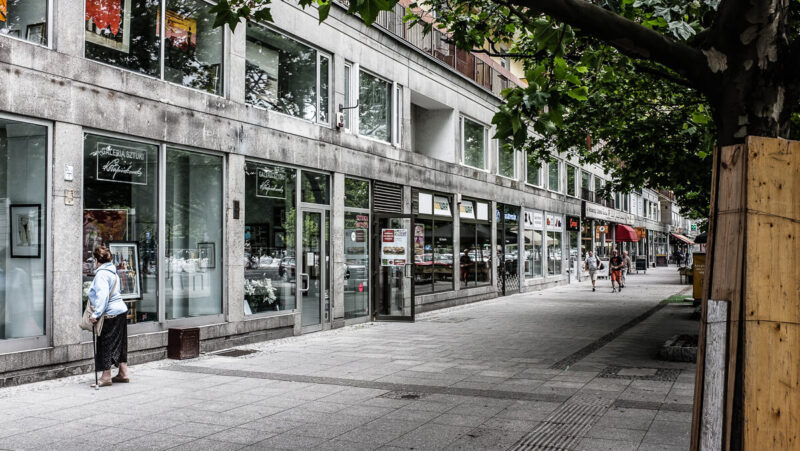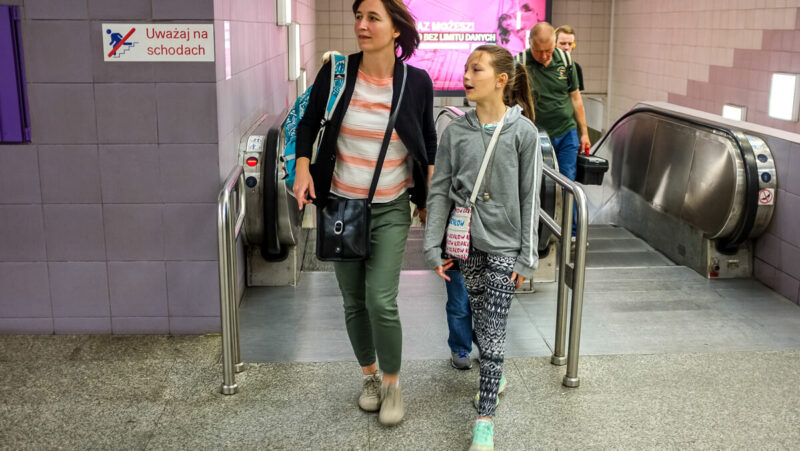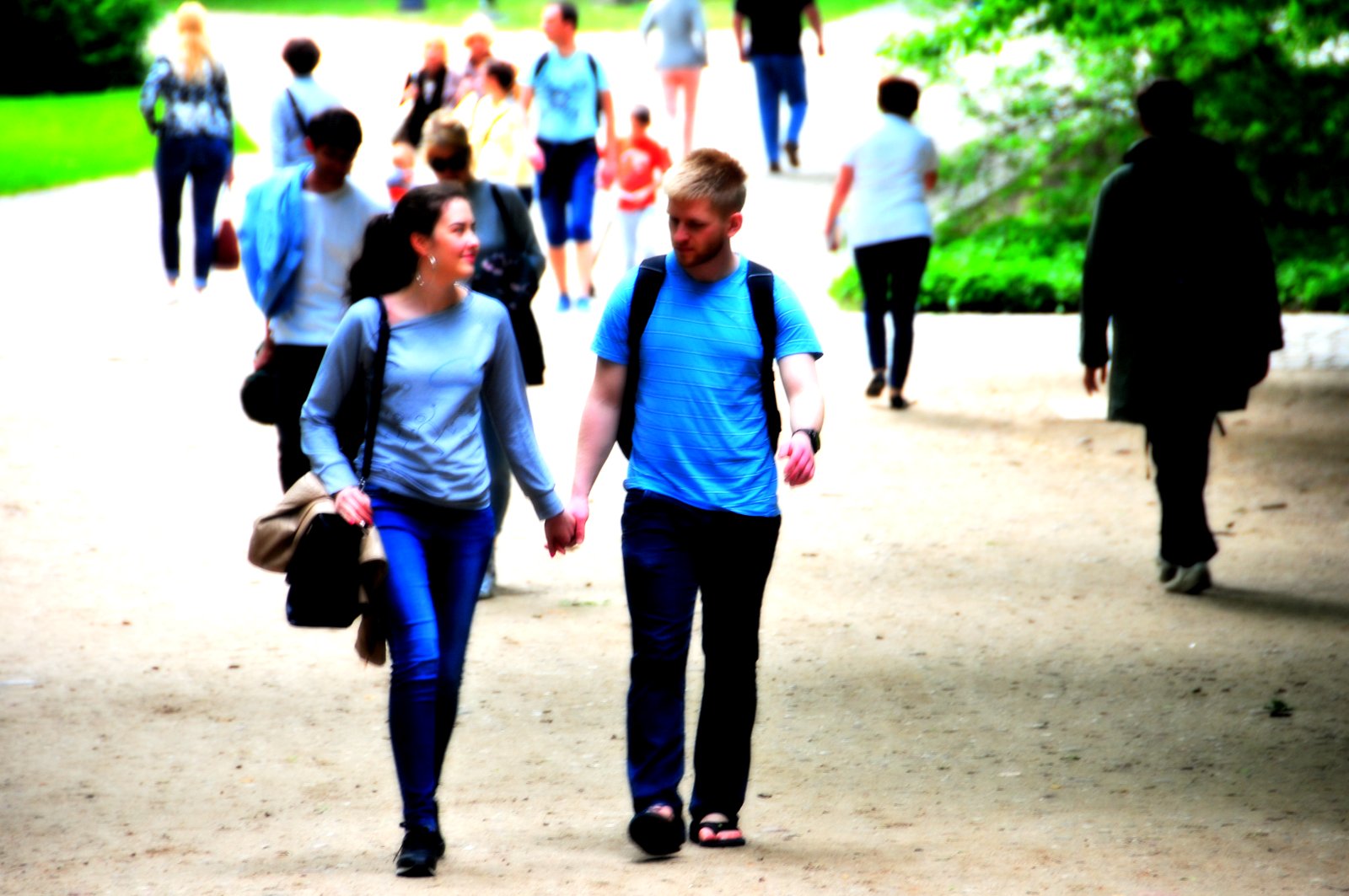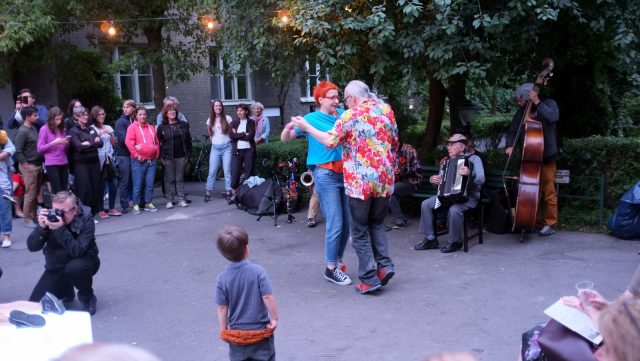Where do you start when you get back from a day of wandering about Warsaw and you have almost 400 pictures that you manage only to whittle down to 78? At the beginning.
We’re all tired from our intense pace these first few days, and it showed when we all collapsed into bed: it was eleven by the time we headed out the next morning. I’d already been out quickly for baked goods for breakfast. A friend who’d visited last night told us she’d passed a promising looking bakery on her way here, so I retraced her steps looking for it. I knew she’d taken the metro to get here, and the nearest station is Rondo ONZ, so I walked along Świętokrzyska Street toward the metro stop, but I saw nothing but old-style shops, all closed for renovation. I kind of wished at least one of them was still open. Still, even with everything closed, it looks like the Warsaw I knew in the late 1990’s.

I couldn’t find the bakery A had mentioned, but I knew that if I just wandered around a bit in a systematic way, I’d find one. And sure enough, half a block later, there was Piekarnia Aromat. This was no typical Polish bakery: not a regular drozdzowka or rose-filled donut to be found. Instead there were things like raspberry brioche and something called “buleczka z pistacjami.” Literally, “a roll with pistachios,” it was a big hit with everyone — but L, of course. She was happy with her chocolate filled something-or-other.

Our plan for today was simple. In fact, we only had one thing on the agenda: Łazienki Park. It was a cool, overcast day — perfect for a long walk in the park. In the end, we spent about five hours there, and we could have all easily spent more.

First, though, we had to get there. We walked down along the edge of Park Świętokrzyski on our way to the Świętokrzyska metro station. The Boy was already counting the modes of new transport he’d experienced: “First a train, now the subway!” He thought for a moment and asked about trams.
“Later. Maybe even today.”

“Yesss!” (At one point the other day, when encouraged to “mow po polsku” he explained that “taaaaaak!” just doesn’t express happiness like “Yesssss!”).

A few stops later, we got off at Politechnika station, walked a few hundred meters (which included a surprise: a rescue vehicle roared out of the station right as we approached),



and there we were, in the famed Łazienki Park by the statue of Józef Piłsudski. The Boy insisted on a picture.

We wandered around a bit and took a gondola ride. The Boy managed to chalk up another mode of transportation, and the gondolier provided a bit of history, including the sad fact that the peacocks and other animals are harassed almost incessantly. “People will be people,” he concluded rather stoically.




As we were disembarking from the gondola, we met M and her son E, and with our life-long Varsovian as a guide, we continued through the park, eventually making it to the Old Orangery, which is filled with statuary and busts of the most eclectic collection: busts of various Roman emperors — including Caligula — fill the garden, while the interior itself is filled with busts for famous Poles in history, most of them completed by Italians.



As we were leaving, we came upon a group of young people, probably ages eleven to fifteen, who were starting some kind of drawing exercise. The lady running it asked L her name, jotted it down on a name tag with the comment that she was the third L in the group, and gave her some charcoal pencils. (“See, I told you,” laughed M later. “‘L’ has become a very popular name in Warsaw.”)

It turned out that it was a two-hour program. L begged to stay. She didn’t have to beg long. K and I were both thrilled that she had taken the initiative to participate in something like this. We explained that we wouldn’t stick around, that we’d leave her there and explore the park further on our own.
“That’s fine.”

“And you haven’t eaten since breakfast. You won’t be able to each for two hours more at least.”
“That’s fine.”
Our girl is growing up.

We left her among the statuary and went in search of gofry and ice cream. And people watching.
Łazienki Park is perhaps the best place in Warsaw to people-watch. There is an incredible mix of people: tourists, locals from two to one hundred and two, families, lovers.












We returned to a happy girl with two gofry to snack on as we made our way to M’s apartment, where her husband J was cooking dinner for us. Along the way, the big D300 put away, I snapped pictures with the little X100, trying to capture a few images that show the old Warsaw and the new, sometimes separately, sometimes juxtaposed.


There was the drug store that looked just like shops did when I arrived first in 1996.

There was an enclosed soccer field that seemed timeless, as if it had always been there.

There was a middle school with graffiti and rebar.

A newstand (“This, this, this is a newstand! I have meat here!” came to mind, a line from my favorite Polish film. In Mis, though, the newstand is not in a kiosk but its own building.) across from a used clothing store that sells clothes by weight.

And lots of people just going about their business.
Dinner and the evening flew by as it does with friends you haven’t seen in years. The conversation ranged far and wide, and for once there were no worries about whose toes we might step on with this or that comment when things turned to more political matters. We don’t see eye-to-eye on everything, and we can talk about it rationally and leave disagreements be. Not that that happened this evening. Parenting and parenthood tended to dominate the conversation and the environment in general.






After dinner, one last adventure: a neighborhood concert just a few blocks away in Szare Domy, a neighborhood of blocks of flats dating from the twenties that have small garden areas tucked in between the blocks. Usually closed off to non-residents, the neighborhood was throwing something like a block party, and everyone was invited.
The kids played. The adults chatted. The residents who stayed at home watched from the balcony.






Finally, around nine, everyone called it an evening. The Ds went back to their apartment after walking us to the nearest tram stop.

We made it back to Emilii Platter Street without worries, did some shopping, and had a final, amusing encounter. Walking out of the shop, E asked K, “Mommy, can I have the banana now?”
“No, just wait till we get back to the apartment,” she replied in Polish.
A young man sitting on a bench called out after us in English: “Why does he speak English when she speaks Polish?”
I turned around and summed it up as quickly as I could: “American reality.”

Beautiful! ( I know how tough it is to post after such a full day. But it was thrilling to read and walk through it all with you. Thank you!)
I’ll try not to double comment on every single post you write, especially on your visit to Warsaw, but you have to understand, I am a child of this place. This is the song I grew up loving: https://www.youtube.com/watch?v=cjL6re5ascs.
And when I was a teen, this is what I listened to: https://www.youtube.com/watch?v=dDg32Azyf4w
My generation — we had such feelings for our city, even at a time when it did not look as well tended as it does today. In fact, physical beauty wasn’t at the forefront: more important was our shared history. It sounds hokey and trite, but this feeling of shared time and space was and is very real. I think all my Warsaw friends who were the post war babies of Poland would agree that it defines who we are.
I was thinking about your comment from the previous post. (I didn’t see it until we got back last night.) I keep talking about communist-era architecture and it might have seemed like I was taking a somewhat derogatory stance toward it, but I think it’s beautiful in its own way. It is an outward reflection of the resilience of the Polish soul, indeed, of the human soul. It’s not always “pretty.” It’s not always perfect. But it does the job, and its flaws — I’m thinking of the ideology behind socialist realist architecture, the idea of function above aesthetics, the notion reflected in Dr. Zhivago that “the personal life is dead” and how that’s reflected in the ideology behind art, architecture, etc. — come out of a poorly executed effort to make life better. And at heart, I’m a sucker for nostalgia. (It utterly broke my heart when I found out that the bus stop in Nowy Targ was torn down.)
Regarding your generation in Warsaw, you grew up at a time when Warsaw was just coming out of the ashes of WWII. I’m sure you have memories of seeing rubble piles still from the war even in the sixties. (A little research showed me that the Royal Castle rebuild wasn’t completed until the early seventies.) So it seems you grew up at a time when living in Warsaw seemed like you were living in a city that everyone was resurrecting together. I certainly understand why it’s so special to you.
I do have very complicated feelings for this very complicated city. Krakow is a piece of cake — pretty, walkable, historic. Warsaw is a mess, but as you say, we learned to love that mess and its resilience to all that had been thrust on her. Then, in the 60s, the sadness of seeing her (economic, architectural, etc) stagnation took hold. My high school class had “prace spoleczne” — to work on rebuilding that castle. But by that time, we were a cynical lot and anything the government asked of us was viewed with suspicion and most often disdain.
But in the last decade — even as so many cities in central Europe fell into a state of decline, Warsaw rebounded again! People from Krakow have an intellectual arrogance about their town, but Varsovians don’t look at life that way: innovation, entrepreneurial spirit, artistic experimentation — they are plentiful in Warsaw. That’s what we care about.
Separately, I have to say that even when you’re not writing about Poland, your blog is my favorite from all the ones I read. You touch on so many aspects of life and your writing is both personal and observational, without intrusion, disdain or criticism for the perspective of those around you. So again, even though I know you don’t really do it for the random reader, this random reader really, really appreciates all your work here.
Okay, now I truly will retreat and just listen for a while! :)
It’s ironic that you should say that, because on the drive back from visiting friends in Targowek, B drew the same comparisons between Warsaw and Krakow, pointing out from a tourism point of view, Krakow is a much easier city to sitesee. You camp out in Stare Miasto and that’s pretty much it. Sure, if you want to go to Schindler’s factory, you’ll have to cross the river, and there are a few other attractions beyond the center, but as you know, you can stay for several days in the Old Town without any issue. Warsaw, B explained, has activities and sites in little cells sprinkled around the whole city. You can’t just camp in one spot.